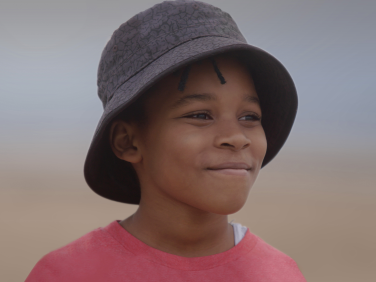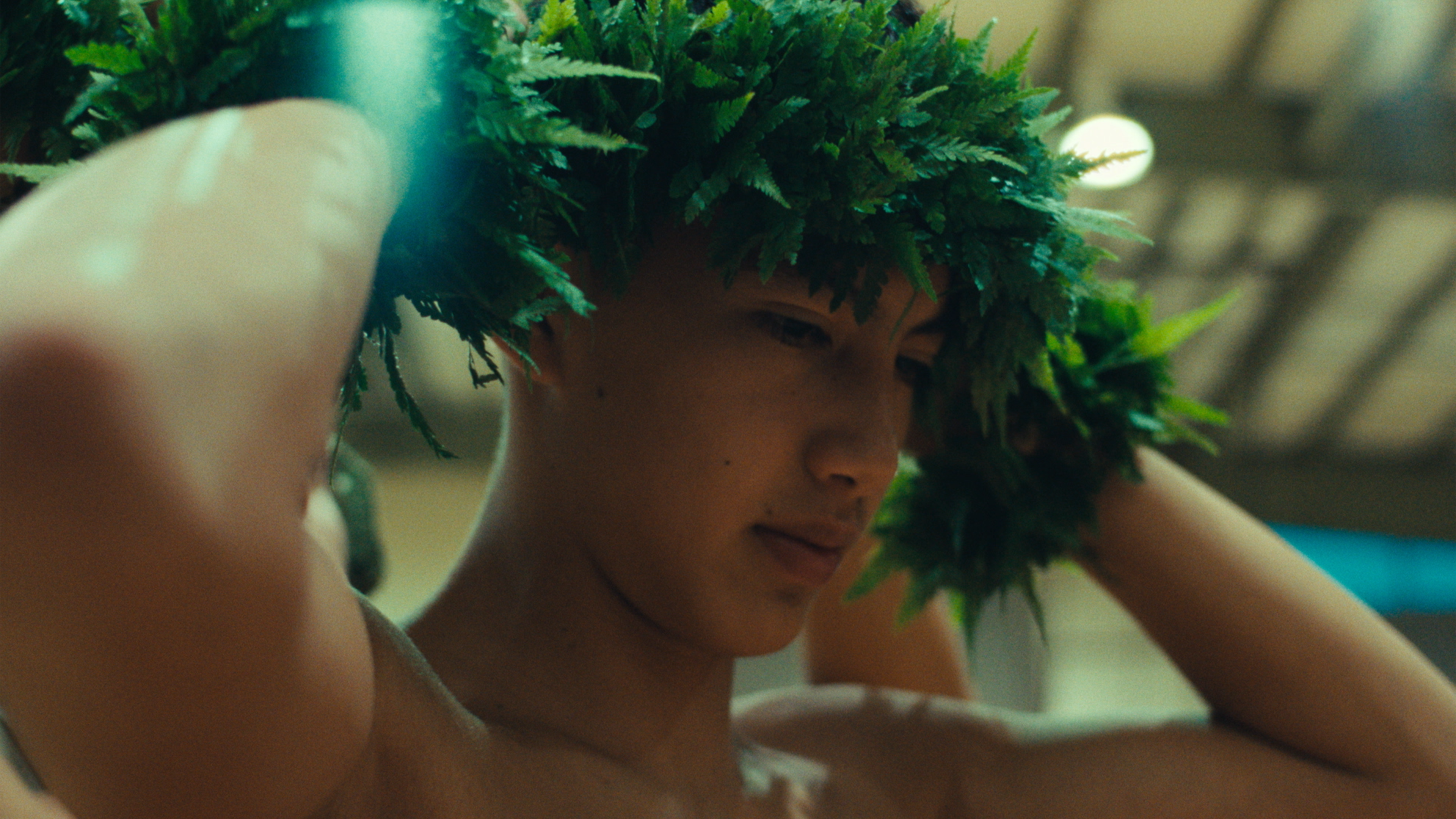
Through Our Eyes
Short documentaries reveal kids’ strength and perseverance as they experience parental incarceration, climate displacement, the wounds of war, homelessness, and more.
From the producers of Sesame Street, Through Our Eyes was designed as a co-viewing experience for adults and kids ages 8 and up. Each stand-alone 26 minute film is directed by an award winning filmmaker.
Watch On: Nationwide Public Television (Check local listings) | 
RECLAIM
Cultural Preservation
Hawaiian cultural practices are a source of pride and joy, but they have faced threats of extinction due to colonization and oppression. In Reclaim, Honor and his older brother Hanalei connect to their Hawaiian roots through language and the rigorous practice of hula, honoring their ancestors, preserving their heritage, and eventually rising to compete in the prestigious “Olympics of hula.”
“We hope that as you explore this film with your keiki, it will inspire conversations around their connection to their own cultural heritage and identity. We hope that it sparks their curiosity to ask what sorts of cultural practices they come from, they can connect to, they can practice, uphold, and pass down.”
Directed by Geeta Gandbhir, Written & Produced by Justyn Ah Chong
Family Journal
As you watch “Reclaim” with your child, use this Family Journal to explore your ideas and questions, and enjoy sharing your own family stories and traditions. This can help connect all of us to our past, present, and future.
Reclaim Resources:
- Ke Kula Kaiapuni o Ānuenue is a K-12 Hawaiian language immersion public school on O’ahu where students learn the Hawaiian language and traditional cultural values.
- Kumu Hula Lono Padilla and Kumu Hula Robert Keano Ka’upu IV run Hālau Hiʻiakaināmakalehua, a school of learning and growth for those pursuing the art of hula.
- Merrie Monarch Festival honors the legacy of King David Kalākaua, who inspired the endurance of Hawaiian traditions. It features an internationally acclaimed hula competition, arts fair, grand parade, and more.
- Ka Wai Ola – A news publication with educational and inspirational stories from the Office of Hawaiian Affairs (OHA), a state agency responsible for Native Hawaiians’ well-being.
- Kanaeokana – Educational resource website promoting Hawaiian culture, from learning Hawaiian language to community events. The “Waihona” space links educators and resources.
- GoHawaii – A visitors’ guide with information and stories of cultural and environmentally conscious experiences and ways for visitors to connect with Hawai’i and its people.
- Kaiwakiloumoku – Educational resources relating to Hawaiian culture, from the Kamehameha Schools trust.
- Hula Preservation Society – An organization dedicated to archiving and sharing the rich history of hula and its cultural practitioners.
- NPEACE brings educational programs to Native Hawaiian communities with ‘ohana (family)-focused models, empowering community members to become educators and leaders.
- Hawaiʻi Peopleʻs Fund has helped support, build capacity, and amplify the impact of grassroots social change movements in Hawaiʻi since 1972.
LEADING
Youth Activism
Youth everywhere are following in their elders’ footsteps and taking action on issues they care about. “Leading” follows two budding activists: Kali who organizes a Black Lives Matter march, and Audre, who creates a school assembly about fighting Asian hate. On the way, both show great commitment and learn how to lead by example.
“We hope that this film can inspire a conversation between you and your child about any injustices they may have experienced or noticed in society. Together you can think critically about how they can help folks who are affected by those inequalities.”
Directed by Grace Lee
Family Journal
This Family Journal is designed to support you, your child, and the rest of your family as you watch “Leading.” Together, you can explore ideas about how we can all use our voices and actions to help make our world a fairer and more welcoming place for everyone.
Leading Resources:
- Inspired by the legacies of social justice movements, The Radical Monarchs creates opportunities for young girls and gender expansive youth of color to celebrate their identities and contribute to their communities.
- Kids 4 Freedom & Justice is a space for children of color to practice liberation and create kid-centered actions for justice.
- DoSomething is one of the largest nonprofit organizations exclusively dedicated to young people and social change, activating millions of youth to take action and make an impact.
- The Alliance for Youth Action empowers local young people’s organizations across the country to engage in our democracy as organizers and leaders
,and to ensure that young people’s voices are heard. - Advocates for Youth partners with young people and their adult allies to champion youth rights to bodily autonomy and build power to transform policies, programs and systems.
APART
Parental Incarceration
America has the world’s largest prison population, and 1 in 14 children in the country will experience the incarceration of a parent. Apart, follows Lyric, Eric, and Nnadji as they contend with the incarceration of parents with whom they maintain a deep connection despite physical distance.
“We hope that these stories can be a tool in helping your child learn about kids with challenging family circumstances… or even reach another child who is going through a similar situation.”
Directed by: Geeta Gandbhir and Rudy Valdez
Family Journal
As you and your child watch “Apart” together, use this Family Journal to support you both and to investigate ideas and questions about how the structures of families may change from time to time and how you can remain resilient and stay connected.
Apart Resources:
The incarceration of a loved one can be overwhelming for children. Perceived stigma can lead to silence—but open and honest conversations can answer kids’ big questions, help them understand that they are not alone, and promote healing. These organizations can offer a place to start.
- We Got Us Now is built by, led by, and about children of incarcerated parents. Their curated list of books for all age groups invites families to learn more.
- The Osborne Association works to prevent and reduce the damage caused by crime and incarceration. They offer a wide range of resources for children of incarcerated parents
- Alliance for Justice for Families is a NY State organization for criminal justice reform that has a family support unit with information on individual and family counseling.
- Hour Children works to help incarcerated and formerly incarcerated women with children successfully rejoin the community, reunify with their families, and build independent lives.
- Sesame Workshop provides free, bilingual resources to help the caring adults in children’s lives guide them through difficult moments with love and support.
Reflection
1 in 14 American children will experience parental incarceration, and 2.7 million children have a parent in prison right now.
Source: Across Prison Walls, I Felt My Parents’ Love, Chesa Boudin
Source: American Psychological Association
SHELTER
Homelessness
The homelessness crisis can feel distant until seen through a child’s eyes. Shelter follows three unhoused children and their parents in L.A. as they seek steady shelter and try to keep their dreams alive. Skylar and Nicholas both live day to day, shuffling between temporary motel stays and living in cars; while Victoria’s family reclaims an abandoned house as their own.
“My hope is for this story to inspire you to talk about what home means to your family physically and emotionally.”
Directed by: Smriti Mundhra
Family Journal
This Family Journal is about one thing we all need, shelter. Watch “Shelter” together with your child and use this journal to explore your ideas and questions about how we can help make our world a kinder place for everyone.
Shelter Resources:
Losing one’s home brings enormous challenges, yet families can build a sense of hope and learn ways to cope. These organizations can offer a place to start.
- Reclaiming Our Homes is the movement started by housing activist Martha Escudero in California.
- The Mom’s 4 Housing collective of homeless and marginally housed mothers works to fill empty houses in Oakland and the Bay Area with people who need shelter.
- The Children’s Defense Fund is a national organization with many resources including the annual State of America’s Children, which includes a chapter on homelessness & housing insecure youth.
- SchoolHouse Connection is a national nonprofit working to overcome homelessness through education.
- School on Wheels supports unhoused kids through tutoring, providing learning equipment (like chromebooks) and ongoing community building and mentorship.
- My Friend’s Place has a wide range of resources and programs for youth experiencing. homelessness, especially those no longer living with parents or guardians.
- Homeless Children’s Network has a family support unit focusing on casework, mental health awareness, and therapy for children.
- Family Promise helps homeless and low-income families achieve sustainable independence by providing prevention, shelter, and stabilization services.
- Sesame Street in Communities provides free bilingual resources to families in crisis and providers who support families and children coping with shelter insecurity and difficult transitions.
Reflection
At least 1 in 6 homeless people in the US are children.
Sources: Children’s Defense Fund: The Affordable Housing Crisis Leaves Children Vulnerable and March 2021 United States Government Accountability Office Report to Congressional Committee
Over 100,000 children in America don’t know where they’ll be sleeping tonight.
Sources: Children’s Defense Fund: The State of America’s Children 2020 and The 2020 Annual Homeless Assessment Report (AHAR) to Congress.
HOMEFRONT
Military Caregiving
In the US, more than three million children live in homes with service members and veterans who rely on caregiver support. Gabby, Terry, and Luther all have parents who were injured while serving, and each family has found a way to heal the wounds of war.
“We made this film to bring attention to the experiences of the children of veterans. Through the voices of three remarkable kids, we witness the unique struggles that they and their parents go through, as they reconnect and rebuild their families.”
Directed by: Kristi Jacobson
Family Journal
This Family Journal is about how families work together to help each other every day. Watch “Homefront” together with your child and use this journal to explore your ideas, questions, and thoughts about how our families go through changes and challenges together.
Homefront Resources:
When a veteran requires caregiving at home, the whole family often takes on support roles—including children. Little is understood about the impact of caregiving within military families, but there is a growing understanding that better support systems are needed. These organizations can offer a place to start.
- The Elizabeth Dole Foundation’s programs provide military and veteran caregivers the support they need at the local, state, and national levels.
- Hidden Heroes provides support, resources, and community for military caregivers and raises awareness of the pivotal role that they play in nurturing veteran families.
- Rosalynn Carter Institute for Caregivers provides free and confidential coaching for the families and friends of returning service members and veterans to manage difficult transitions.
- VA Caregiver Support: offers services for caregivers including online and in-person classes and telephone and in-person support.
- Veteran Caregiver Support, created by Operation Homefront, cares for wounded, ill, or injured service members and veterans and fosters connections among caregivers.
- Blue Star Caregivers: programs for caregivers including social events, peer support, coffee chats, and digital resources.
- America’s VetDogs trains and places skilled guide dogs with military veterans who experience both invisible and visible wounds.
- Sesame Street for Military Families: Caregiving is an initiative to support military and veteran families as they care for a wounded, ill, or injured parent or relative.
Reflection
In the US, there are 1.9 million service members and veterans relying on caregiver support. 3.4 million children live in the homes of these caregivers.
Source: “Military Caregivers: Who are they? And who is supporting them?” RAND Corporation. 2014.
UPROOTED
Climate Displacement
Since 2016, millions of people in the United States have been displaced by weather-related disasters that are occurring more frequently and with greater intensity due to climate change. In Uprooted, two families with young children grapple with climate-related crises.
“By showing the experiences of Emma, Leo, and Mariah, all of whom are facing the loss of their homes due to the effects of climate change, we hope that young people will more easily understand the issue and be inspired to do something about it.”
Directed by: Talleah Bridges McMahon
Family Journal
As you and your child watch “Uprooted,” use this Family Journal to explore your ideas and questions about how we can all become environmental stewards. Here, you will find an introduction to the children in the episode, useful information just for you, and printable pages for your child.
Uprooted Resources:
Climate change is often a tough topic to discuss with children in a way that is both honest and reassuring. For families experiencing displacement due to climate change, helping children navigate the issue and their own feelings can be especially challenging. These organizations can offer a place to start.
- The National Resources Defense Council is an advocacy organization. To help families and caregivers answer challenging questions, they have created a Guide to Talking With Kids of All Ages About Climate Change.
- NASA created Climate Kids for upper-elementary-aged children. The site has games, activities, and articles that make climate science accessible and engaging.
- The CDC offers guidance on how to prepare for a natural disaster and how to help a child cope in the aftermath.
- The American Psychological Association has also put together a list of tips to aid children in their emotional recovery from natural disasters.
- SBP is dedicated to helping families across the country prepare for disaster and have created this short video of five tips to ensure your home and family are protected.
- The Child Development Institute lists tips for how to help children adjust to a new home–helpful when families are displaced because of a severe weather event.
- The American Academy of Pediatrics hosts a site dedicated to helping parents raise healthy children that offers advice on How Families Can Cope with Relocation Stress After a Disaster.
- Sesame Street in Communities provides free, bilingual resources for children and families as they prepare for an unexpected emergency or recover from one—helping caregivers provide reassurance and comfort even on the toughest days.
Reflection
A “climate displacement” occurs each time someone is forced from their home due to a climate-related disaster. Since 2016, there have been more than 6.5 million climate displacements in the United States.
Source: The Internal Displacement Monitoring Centre (IDMC) data for the United States.

